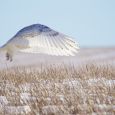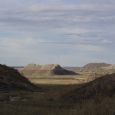The Gift of South Dakota
Subscriptions to South Dakota Magazine make great gifts!
Subscribe today — 1 year (6 issues) is just $29!
Boundary Walker
 |
Editor’s Note: This story is revised from the May/June 2000 issue of South Dakota Magazine. To order a copy or to subscribe, call 800-456-5117.
Emmett Bennett walked the streets of Rapid City five days a week for 25 years. He walked with purpose, delivering the mail. On weekends, for relaxation — and to stay in shape for Monday — Emmett and his wife Mary Ellen took a hike.
Bennett had volunteered for the army in 1940, and fought in Africa. After the war he took a job with the postal service, where he resisted all attempts to move him to inside jobs. He retired in 1970, but even before he delivered his last piece of mail, he had found a new reason to walk.
One day in 1963, Bennett reached the city limits, but kept on walking. Then he found a purpose for his exploration of the Black Hills — searching for the boundaries of 19th-century mining claims. Emmett and Mary Ellen's children were in scouts, and Emmett took the scouts out to teach them to use a compass. While surveying an old claim in the western Hills, he stumbled across U.S. Locating Monument No. 79, and a new passion was born.
Having discovered that surveyors had marked the boundaries of the state with cottonwood, iron or granite posts at every mile a century earlier, Bennett began a trek around western South Dakota. He resolved to rediscover and map the lost and forgotten markers that encircle the entire state, except the southeast corner where the Big Sioux and Missouri Rivers provided a natural boundary.
"I have no idea what motivated him," said his lifetime mate. "He did like to hike, and he liked to have a purpose for hiking. It was a challenge to find as many of the original surveying markers as he could, and to get from one to the next. For him to take a walk he had to have some place he wanted to go."
 |
Bennett began the western boundary at the southwest corner of the state, where South Dakota, Nebraska and Wyoming meet, the spot where Rollin J. Reeves, guided by the stars, began his survey in 1877. Reeves marked the border to the Montana line, roughly following the 104th meridian. Every mile he planted a cottonwood post, inscribed with a mile number and the name of the state on either side. The rest of the western border, with Montana, was surveyed seven years later by Daniel G. Major.
In 1904 the line was resurveyed, the Wyoming border by Edward F. Stahle and the Montana section by Frank S. Peck. This time the boundary was marked more permanently, with 6x6-inch, 6-foot granite posts where it was possible to deliver them, or with 3-inch by 4-foot iron posts with an inscribed brass cap. Many of the granite posts were quarried in Sioux Falls, hauled as far as possible by train, and then by mule wagon to the appointed place.
Though the original wooden markers were presumably rotted away by Emmett Bennett's time, he found most of the granite and steel replacements intact, though sometimes askew. When he found posts leaning, he occasionally took the time to set them right. Bennett's mapping work was so much appreciated by South Dakota's Society of Professional Land Surveyors that in 1999 they honored him for his contributions to the profession.
On some searches Mary Ellen walked with him; other times she dropped him off, then picked him up at the next crossroad a few miles up. Occasionally they lost each other, but as long as there was another boundary marker to find, Emmett kept walking. Sometimes other motorists would stop to see if Mary Ellen had a flat or needed help. "Oh, no, my husband's just wandering out there," she'd say. "I drop him off here and wait for him up yonder."
Using whatever maps were available and a compass to guide his feet, Bennett walked several miles of sometimes rugged, pathless terrain a day — once a 10-mile stretch. He gauged the distance between markers with his watch, 20 minutes per mile in open country. Mary helped with research and typed up his observations. "He kept good notes, which now are scattered hither and yon," she said.
After he found and described as many of the western border markers as he could, Bennett turned his attention to the northern boundary. He read Gordon Iseminger's Quartzite Border, and in February 1990, Emmett and Mary Ellen went to the northwest corner of the state and started walking east along the North Dakota line toward the Missouri River. The first day's hike took them as far as the Little Missouri River in Harding County. Many hikes later, Emmett, now 80 years old, had walked every step of the northern boundary to the big Missouri — except a forbidding five-mile buffalo pasture.
In November Emmett and Mary Ellen traveled to the southwest corner, and again Bennett headed east, this time along the Nebraska line. Except for a 30-mile stretch east of Pine Ridge, he walked the southern border to the initial surveying point on the Keya Paha River, southwest of Gregory.
In all these hundreds of miles of cross-country walking, Bennett took careful notes of the location, condition and terrain of every marker he found. His records indicate the date, the mile post number, how much of the marker was showing above the ground, and whether the post was upright, leaning so many degrees in a particular direction, or down. His field notes sometimes included an index card with a drawing of the brass cap atop the post, a map with the legal description, and notes such as "high up on the south slope of the hill" — anything that might help the next searcher find the spot.
 |
| Emmett Bennett rests by the fire tower at the top of Harney Peak on his 80th birthday. |
Thirty years into his boundary walks, having traversed the borders of half the state, Bennett began in 1995 to walk the Base Line — the imaginary east-west stripe across the middle of South Dakota from Jones County, just south of his boyhood home of Ft. Pierre, through the Black Hills to the Initial Point where the Base Line meets the Black Hills Meridian on the Wyoming border. This was the original surveyor's base line, established in 1877 by James A. Williamson, commissioner of the General Land Office, and Henry Esperson, surveyor general of Dakota Territory in Yankton. It was the starting point for surveying western South Dakota and the Black Hills.
By 1998 Bennett had completed that journey, except for a short stretch between Murdo and Kadoka. But he still had not relocated the monument which marks the intersection of the base line and the 100th meridian on the Wyoming border near the Pennington-Custer County line. On August 17 he and Mary Ellen walked west from Redbank Campground, just off Forest Service Road 117 in southwest Pennington County, seeking the point where the West River surveys began. Late in the afternoon she stopped to rest, while Emmett searched on ahead.
Darkness fell, and Emmett did not return. After a frantic night, Mary Ellen called the sheriff. Searchers finally found Emmett the second night, wandering the 6,600-foot Limestone Plateau just across the Wyoming line. disoriented and dehydrated. Apparently he had gotten turned around, and perhaps even blacked out, Mary Ellen said.
Annoyed at getting lost so near his prize, Bennett spent the next couple of weeks studying his maps, trying to figure out where he'd made a wrong turn. He made two trips to Newcastle, Wyo., looking for other possible trails. Then he set out again on the last day of September, determined to find the elusive marker.
Again, Emmett Bennett did not return. This time Mary Ellen was even more alarmed, especially when the night turned cold and rain began to fall. In the morning the Pennington County sheriff dispatched a search and rescue team. Word of the missing man spread, and for the next two days as many as 50 people combed the rugged state-line area. On the third day, a Colorado team with search dogs found Emmett Bennett's body at the bottom of a brushy ravine in Parmlee Canyon, a quarter mile across the Wyoming line, just west of the mile post he sought.
Why Emmett Bennett 's passion to walk? Why the need to be out of doors, whatever the weather? Maybe his birthday has something to do with it. After all, Bennett was born on Earth Day. Or rather, Earth Day was born on Emmett Bennett's birthday, April 22, 1970. Millions of Americans celebrated Bennett's 60th birthday as he did, by walking — marching in demonstrations around the nation to protest pollution of Planet Earth.
Bennett celebrated the 20th Earth Day and his own 80th birthday by climbing Harney Peak, the highest point between the Big Horns and the Alps. But for those who knew him, the feat of climbing the state's highest mountain at age 80 came as no surprise.
The truth is, that when Emmett Bennett walked, it was only because he was pacing himself. He was reining in his natural tendency to run. For not only endurance, but speed was in Emmett Bennett's blood. From 1926-1930, he earned 12 athletic letters at Rapid City High School — in football, basketball and track. In 1929 he placed sixth in the nation in the 440-yard race in Chicago. In 1938 and 1939 he was the city tennis champion. In the early 30s he built his own canoe and paddled most of the streams of western South Dakota.
In 1953, though Emmett had only recently begun flying, he and Mary Ellen entered a cross-country lightcraft air race from Philadelphia to California. They didn't tell their friends about the race, because they weren't sure they could finish. They won first place in their division.
Retired from the post office in 1970, Bennett had more time to play tennis and to walk. A decade later, now in his 70s, he began to supplement these activities with Volksmarching. In three years the Bennetts walked 2,500 miles in 17 states. At 74 he rode his bicycle across Nebraska from Sidney to Papillion, a meandering 512 miles in seven days. Twice he rode across Minnesota.
Then he decided it was time to renew his track career. At age 74 Bennett competed in a triathlon in Northfield, Minn., a 67-kilometer race consisting of 7 kilometers by canoe, 50 by bicycle, and 10 on foot. He completed the 42-mile race in under five hours, winning not only his own age division of people over 70, but beating all the 60-year-olds and even all those over 50.
 |
| Bennett (left) set new records in five of the eight Senior Olympics events he entered. |
A decade later, now 85 years old, Bennett was still running. At the 1995 Senior Olympics in St. Louis, he competed in eight events, including the long jump. In five events he set new records.
So this was the Emmett Bennett who, on that late September day in 1998, set out on his last walk. Perhaps he became disoriented again. Maybe he fell, or blacked out. Or possibly he simply lay down to rest, and didn't get up. The first chill of winter came that night, and by morning he was dead.
Walking was as natural to Emmett Bennett as breathing air. But why the attraction to boundaries for a man whose very life said movement, independence, speed? For a quarter century Bennett walked the line. To earn his bread, he traversed the same prescribed path, day after day. But for 88 years he also pushed the line, tore away at the envelope, lunged toward freedom. He was a man who defied boundaries, pushed himself to the last ounce of endurance, broke through the finish line.
Perhaps there was within him some need for the line, even if artificial or imagined, something to keep him in check, to give life order. Something epitomized by a boundary marked at regular intervals with granite posts.
Otherwise, he might not have returned. He might have simply kept on walking. Somehow, it's comforting to know that the night Emmett Bennett died, he was across the line, beyond the boundary marker he sought.
But this is idle speculation, the rumination of one who sits at a desk wondering, one who might rather be there under the open sky with Emmett Bennett, a man who for 88 years did what he loved doing — putting one foot in front of the other, his eye on some goal up ahead, a mail box, a finish line, a six-foot granite post, the summit of the next horizon.









Comments